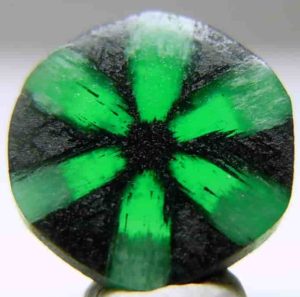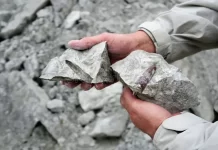
Trapiche Emerald
Trapiche emerald is a rare variety of gemstone emeralds, distinguished by a six-point radial pattern of ray-like spokes of dark impurity. It is one of several types of trapiche or trapiche-like minerals, including trapiche ruby, sapphire, granate, chiastolite and tourmaline. The name comes from the Spanish word trapiche, a sugar mill, due to the resemblance of the pattern with the spokes of the grinding wheel.
Trapiche emeralds were first described by Émile Bertrand in 1879. They are generally only (and rarely) found in the western part of the Eastern Cordillera basin, in the Muzo, Coscuez and Peñas Blancas mines of Colombia (but likely not in Chivor as reported in older literature). Singular finds in Brazil and Madagascar have also been reported.
Trapiche emeralds are found in the black shale host rocks of just a few Colombian mines in the western belt of the Eastern Cordillera Basin. It has a central core, six arms and black schalled dendrites, a crystal-like tree structure, branching around the core between the arms. These are visible when the crystals are positioned perpendicular to the c-axis and are often cut like cabochons to accentuate the six partitions.
The radial pattern has a considerable variance, and often includes a hexagonal structure at the core. There is still no consensus on the mechanism by which the pattern is formed or the conditions required for it. Several models have been suggested. According to one view, the black impurities are the remains of the slate matrix in which the emeralds grew, stuck between the radial dendrites of the growing emerald. The trapiche pattern is not an asterisk, an optically similar pattern that forms in a different phase.
How Does a Trapiche Emerald Form?
During the formation of an emerald crystal, black carbon impurities may enter the gemstone mix. Because of emerald’s hexagonal crystal structure, these impurities may fill in at the crystal junctions, forming a six-point radial pattern. In some trapiche emeralds, inclusions of albite, quartz, carbonaceous materials, or lutite may outline the hexagonal emerald core. From there, they extend in spokes that divide the surrounding emerald material into six trapezoidal sectors.
The main, tapered emerald core first grows under hydrothermal conditions, but if these conditions slow down or even stop for some time, impurities may enter the mixture. As growth conditions resume, both the emerald and, for example, the albite will form. Although the hexagonal prism faces of the core crystal can maintain their uniform growth, producing pure emeralds, the albite fills the areas growing from the edges between the prism faces. This results in six sectors of clear emerald and six of a combination, predominantly albite and some emerald. Therefore, the central core and the six surrounding trapezoidal sectors of the trapezoid emerald form a single, untwinned crystal.
Although the hexagonal core may often be colorless, transparent beryl, it can also be green. In a 1970 analysis of Muzo, Colombia’s trapiche emeralds in American Mineralogist, K. Nassau and K. A. Jackson found their principal coloring agent was vanadium.
Other species of Trapiche Gems
Trapiche emeralds were first sent to GIA for study in the mid-1960’s. After then, a six-armed trapiche texture or pattern has been found in a few other gemstones, most notably sapphire and ruby.
In 1995 GIA first documented trapiche rubies from Mong Hsu, Myanmar and have since been found in Guinea, Kashmir, Pakistan , Nepal, Sierra Leone and Tajikistan. Trapiche sapphires first appeared on the gem market in early 1996, when samples were sold by a Berlin gem dealer in Basel. Trapiche sapphires have been found primarily in Australia, Cambodia, China, France, Kenya, Madagascar, Nepal , Sri Lanka and Tanzania.
All trapiche gemstones are relatively rare and some even more so. Some examples of the more rare or unusual trapiche gemstones include:
- Pezzottaite (named after mineralogist Dr. Federico Pezzotta) first appeared at the 2003 gem shows in Tucson. Since then it has become a rare, coveted gemstone by collectors worldwide. It is a member of the beryl group, along with emerald and red beryl. All three are prized when in trapiche formation.
- Tourmaline is relatively abundant in Zambia, although only a small percentage of crystals exhibit the trapiche pattern.
- Trapiche muscovite comes from only one locality, the Japanese city of Kameoka in Kyoto Prefecture, where they are locally known as “cherry blossom stones” (sakura-ishi in Japanese.)










